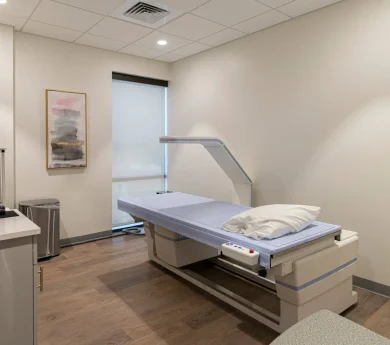Screening Mammography
The purpose of screening mammography is to find breast cancer at a very early stage. A screening mammogram is recommended once a year for women of average risk, age 40 and older, who are healthy, not pregnant, and who are not experiencing any breast related concerns. Some women will need to begin screening mammography earlier than age 40 depending on family and medical history.
A mammogram is an x-ray examination consisting of 2 views of each breast taken by a certified technologist. Sometimes more than 2 views of each breast are required. At least 4 views of each breast are required to adequately evaluate breasts with implants. Screening mammography is a quick in-and-out appointment lasting between 15-30 minutes from check-in to check-out. You will receive results through our patient portal and by mail. Receiving results may take longer if your previous mammography was done at another facility. Your primary physician also receives a report of the results 1-2 days sooner by fax, or at the same time by mail.
All screening mammography done at Breast Center of Naples utilizes the latest technology, DBT (digital breast tomosynthesis), which is proven by research and recommended by experts in the field of breast imaging. Research has shown that using this technology improves the cancer detection rate of screening mammography while decreasing the recall rate.
Screening Whole Breast Ultrasound
The purpose of screening breast ultrasound (SBU) is to help detect small, early stage, breast cancer in women with dense breast tissue (which is assessed on mammogram as Category C – Heterogeneously Dense or Category D – Extremely Dense). SBU is done at the same time as the screening mammogram so that the radiologist can interpret them together. The ultrasound is performed by a specialized certified technologist and takes an extra 15-30 minutes.
Bone Density
A bone density test (DEXA) is a fast screening X-ray procedure to measure bone loss. The test is usually done on bones that are most likely to break because of osteoporosis including the lower spine, thighbone, or forearm. The test is performed by a radiology technologist and interpreted by the radiologist.
Diagnostic Mammography
This x-ray exam is performed by a certified technologist for women over the age of 30, or men of any age, who present with a breast symptom or problem. It may also be used if a woman is recalled for an abnormality on her screening mammogram.
This may include only the standard views as performed for a screening mammogram, but usually will include additional specialized views to best assess the abnormality or problem.
Diagnostic Breast Ultrasound
A certified technologist will scan the targeted area or areas of concern in the breasts using a hand-held probe and save images for the radiologist to review. Sometimes the radiologist will also scan the patient prior to giving the results of the examination.
Needle Biopsy
Ultrasound-guided Biopsy -
This image-guided biopsy procedure uses live, real-time ultrasound imaging to guide the biopsy needle directly to the targeted suspicious finding. The radiologist conducts the live imaging and directly observes the position of the needle while performing the biopsy to ensure a reliable and accurate biopsy diagnosis.
Stereotactic Biopsy -
This image-guided biopsy procedure uses mammogram images to target the suspicious finding in the breast which are processed using specialized equipment and computer software. The radiologist analyzes these images to accurately aim and guide the biopsy needle to the targeted area.
Ultrasound-guided Cyst Aspiration
The radiologist inserts a thin needle into a cyst using ultrasound guidance. This can be performed for therapeutic purposes if a cyst is painful or bothersome to the patient or for diagnostic purposes if the cyst is not clearly benign on ultrasound.
Image-guided wire or wire-free localization
This procedure is used to help the surgeon accurately locate an area of concern. If a wire is used for localization of the area of concern, this will be performed the day of surgery and will be placed using ultrasound or mammography. If a wire free device, such as Savi Scout or Magseed, is used this can be placed prior to the day of surgery.
Advanced Body Composition Scan
Our Advanced Body Composition Scan (also known as BodyLogic Scan) allows for a more comprehensive way to measure body composition when compared to other methods. This in-depth analysis provides you with percentage body fat, total lean mass, bone density, limb comparison for muscle imbalance detection, visceral fat and more. Visceral fat is located in the abdominal cavity near many vital organs, which may predispose serious health risks including cardiovascular disease. This is not a replacement for your normal bone density study. The scan does require a doctors order and is not covered by insurance.





